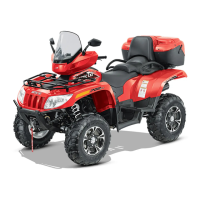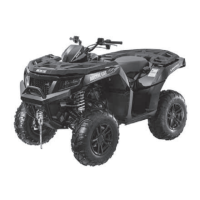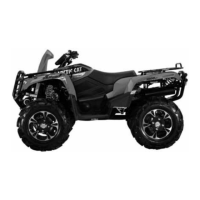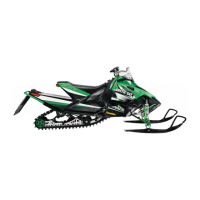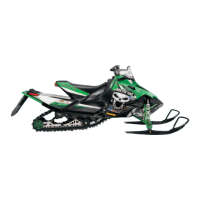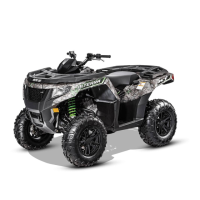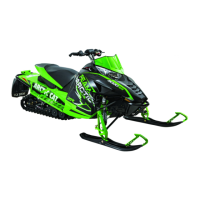Do you have a question about the Arctic Cat 500 4x4 and is the answer not in the manual?
Safety advice and protective clothing requirements for safe ATV operation.
Essential pre-ride checklist to ensure the ATV is in safe operating condition.
Process to optimize new brake pad efficiency by heating them.
Form for recording essential ATV and owner identification information.
Details on engine type, bore, stroke, displacement, ignition, and carburetor.
Key dimensions, suspension travel, wheelbase, and tire sizes for different models.
Includes dry weight, capacities, fluids, and electrical data for various models.
Visual diagrams identifying key components and controls on the ATV.
General safety warnings, rider training advice, and initial checks.
Location and importance of Vehicle Identification Number (VIN) and Engine Serial Number (ESN).
Operation, positions, and indicator functions of the ignition switch and lights.
Display functions and warning indicator lights on the instrument panel.
How to engage 2WD/4WD and proper use of the parking brake mechanism.
Operation of electric starter, choke, and throttle lever for engine control.
Adjusting throttle travel, and operation of hand brake levers.
Procedures for fueling and checking engine oil level.
How to secure the seat and maximum load limits for vehicle racks.
Installation, adjustment, and threading specifics for rearview mirrors.
Safe practices and precautions for towing trailers with the ATV.
Methods for safely securing the ATV during transport.
Specifications for gasoline, engine oil viscosity, and differential lubricant.
Initial operation guidelines to ensure ATV longevity and performance.
Step-by-step process to condition new brake pads for optimal effectiveness.
Routine lubrication of cables and engine/transmission oil and filter replacement.
Checking brake pads, fluid level, and hydraulic system functionality.
Servicing the battery and inspecting protective rubber boots.
Servicing spark plugs, checking gap, and adjusting engine idle RPM.
Adjusting throttle cable free-play and draining carburetor float bowl.
Cleaning air filter, checking hoses, and servicing diesel filter/belt cover.
Correct tire sizes, tread depth importance, and inflation pressure.
Procedure for changing tires and removing wheels safely.
Procedures for replacing bulbs and adjusting headlight aim.
Locating the fuse box and using accessory power terminals.
Steps for properly preparing the ATV for long-term storage.
Procedures for taking the ATV out of storage and preparing it for use.
Techniques for starting, stopping, and performing basic turns.
Using body weight and leaning for better control during turns.
Specific methods for executing wide, sharp, and quick turns.
Techniques for safe riding on uphill, downhill, and challenging slopes.
Advanced techniques for riding on slopes and crossing obstacles.
Handling slides, parking on inclines, and crossing water safely.
Precautions and techniques for riding in snow and ice-covered conditions.
Solutions for issues preventing the engine from starting.
Troubleshooting problems with gear shifting, lights, and horn.
Diagnosing incorrect speed readings and engine performance problems.
Guidelines for using accessories and respecting country-specific regulations.
Overview of warranty coverage, periods, and limitations.
Actions and conditions that will invalidate the ATV warranty.
Steps to follow when submitting a warranty claim.
Procedures for changing owner details or transferring the warranty.
Final remarks on vehicle features, model changes, and accuracy.
Safety advice and protective clothing requirements for safe ATV operation.
Essential pre-ride checklist to ensure the ATV is in safe operating condition.
Process to optimize new brake pad efficiency by heating them.
Form for recording essential ATV and owner identification information.
Details on engine type, bore, stroke, displacement, ignition, and carburetor.
Key dimensions, suspension travel, wheelbase, and tire sizes for different models.
Includes dry weight, capacities, fluids, and electrical data for various models.
Visual diagrams identifying key components and controls on the ATV.
General safety warnings, rider training advice, and initial checks.
Location and importance of Vehicle Identification Number (VIN) and Engine Serial Number (ESN).
Operation, positions, and indicator functions of the ignition switch and lights.
Display functions and warning indicator lights on the instrument panel.
How to engage 2WD/4WD and proper use of the parking brake mechanism.
Operation of electric starter, choke, and throttle lever for engine control.
Adjusting throttle travel, and operation of hand brake levers.
Procedures for fueling and checking engine oil level.
How to secure the seat and maximum load limits for vehicle racks.
Installation, adjustment, and threading specifics for rearview mirrors.
Safe practices and precautions for towing trailers with the ATV.
Methods for safely securing the ATV during transport.
Specifications for gasoline, engine oil viscosity, and differential lubricant.
Initial operation guidelines to ensure ATV longevity and performance.
Step-by-step process to condition new brake pads for optimal effectiveness.
Routine lubrication of cables and engine/transmission oil and filter replacement.
Checking brake pads, fluid level, and hydraulic system functionality.
Servicing the battery and inspecting protective rubber boots.
Servicing spark plugs, checking gap, and adjusting engine idle RPM.
Adjusting throttle cable free-play and draining carburetor float bowl.
Cleaning air filter, checking hoses, and servicing diesel filter/belt cover.
Correct tire sizes, tread depth importance, and inflation pressure.
Procedure for changing tires and removing wheels safely.
Procedures for replacing bulbs and adjusting headlight aim.
Locating the fuse box and using accessory power terminals.
Steps for properly preparing the ATV for long-term storage.
Procedures for taking the ATV out of storage and preparing it for use.
Techniques for starting, stopping, and performing basic turns.
Using body weight and leaning for better control during turns.
Specific methods for executing wide, sharp, and quick turns.
Techniques for safe riding on uphill, downhill, and challenging slopes.
Advanced techniques for riding on slopes and crossing obstacles.
Handling slides, parking on inclines, and crossing water safely.
Precautions and techniques for riding in snow and ice-covered conditions.
Solutions for issues preventing the engine from starting.
Troubleshooting problems with gear shifting, lights, and horn.
Diagnosing incorrect speed readings and engine performance problems.
Guidelines for using accessories and respecting country-specific regulations.
Overview of warranty coverage, periods, and limitations.
Actions and conditions that will invalidate the ATV warranty.
Steps to follow when submitting a warranty claim.
Procedures for changing owner details or transferring the warranty.
Final remarks on vehicle features, model changes, and accuracy.
| Brand | Arctic Cat |
|---|---|
| Model | 500 4x4 |
| Category | Offroad Vehicle |
| Language | English |
